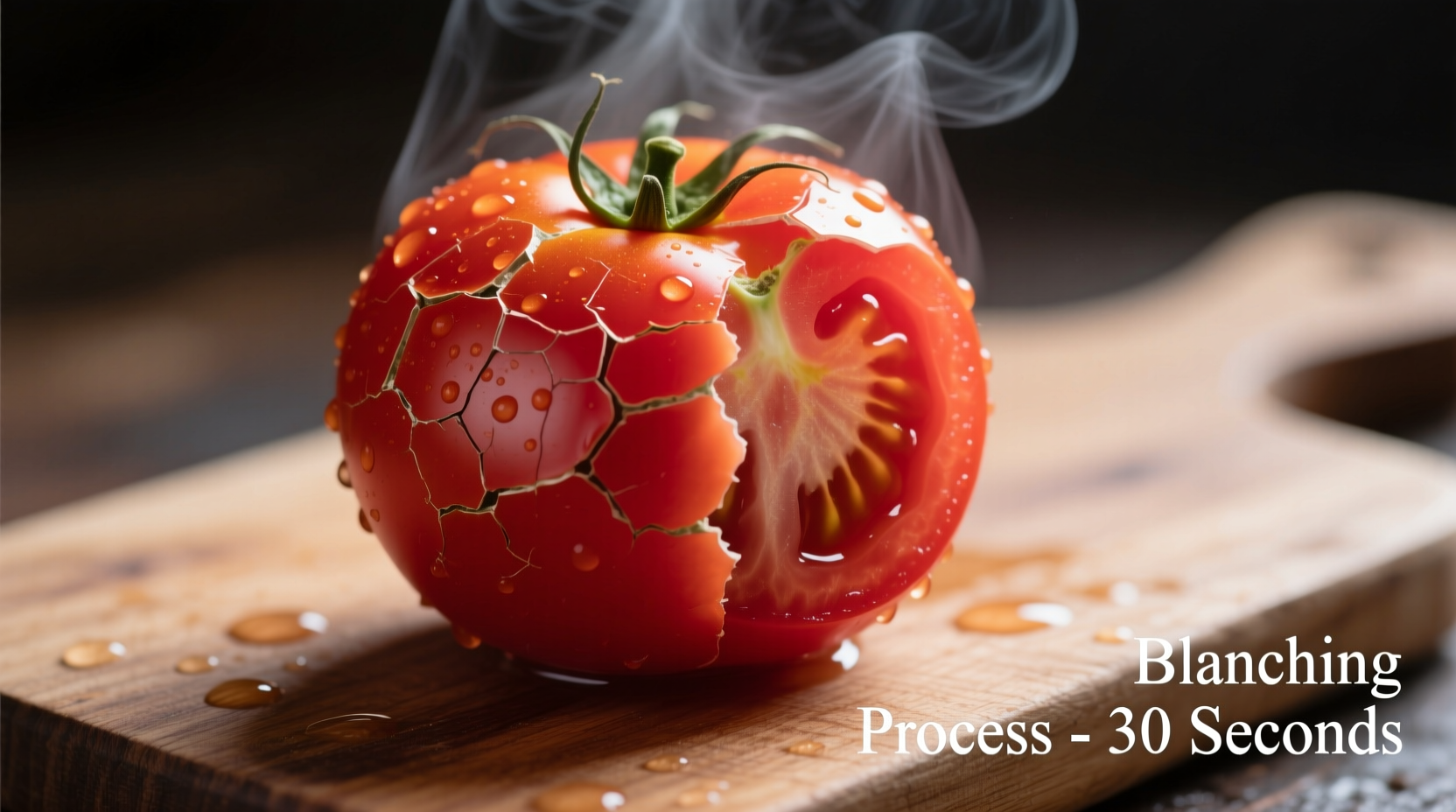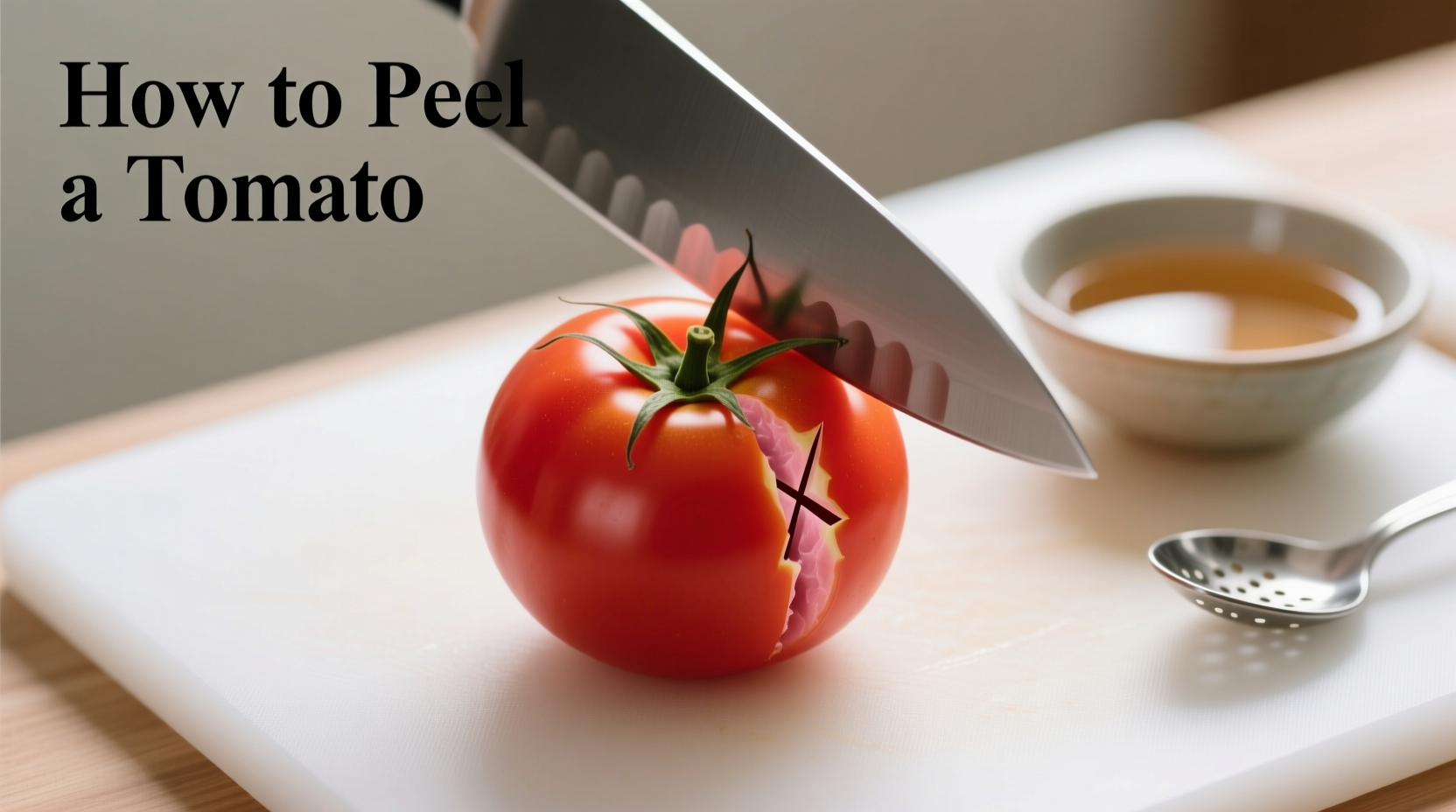The fastest and most effective way to peel a tomato is the blanching method: score the bottom, boil for 30-60 seconds, then transfer to ice water. The skin will slip right off with minimal effort, preserving the tomato's texture and flavor for sauces, soups, and canning.
Why Peeling Tomatoes Matters for Better Cooking Results
While many home cooks skip this step, properly peeled tomatoes transform your dishes. The skin contains tough cellulose fibers that don't break down during cooking, creating unpleasant texture in sauces and soups. Professional chef Antonio Rodriguez explains: "Tomato skins can become tough and separate from the flesh during slow cooking, resulting in an inconsistent mouthfeel that detracts from otherwise excellent dishes."
Essential Tools and Tomato Selection
Before you begin, gather these kitchen essentials:
- Sharp paring knife or tomato peeler
- Slotted spoon
- Bowl of ice water (3 parts water to 1 part ice)
- Medium saucepan
- Small knife for scoring
Choose firm, ripe tomatoes without blemishes. Roma (plum) tomatoes work best for sauces due to their lower water content and fewer seeds. According to USDA agricultural research, "Roma tomatoes contain approximately 10% less water than standard slicing varieties, making them ideal for concentrated tomato products where excess liquid is undesirable" (USDA Agricultural Research Service).
Step-by-Step: The Blanching Method (Most Reliable Technique)
This professional kitchen technique delivers perfect results every time:
- Score the tomatoes: Using a small knife, make a shallow "X" on the bottom of each tomato
- Boil water: Bring a saucepan of water to rolling boil (use enough to cover tomatoes)
- Prepare ice bath: Fill a large bowl with ice water
- Blanch tomatoes: Submerge 2-3 tomatoes at a time for 30-60 seconds (timing varies by size)
- Shock in ice water: Immediately transfer to ice bath for same duration
- Peel skin: Starting at the "X," gently pull skin away with your fingers
Timing is critical—over-blanching makes tomatoes too soft. Small cherry tomatoes need just 20-30 seconds, while large beefsteaks may require 60-90 seconds. The skin should begin curling away from the "X" when properly blanched.

Alternative Methods When Blanching Isn't Practical
Depending on your kitchen setup and recipe needs, these alternatives work well:
| Method | Best For | Time Required | Success Rate |
|---|---|---|---|
| Blanching | Sauces, soups, canning | 5-7 minutes | 95% |
| Broiling/Roasting | Salsas, roasted tomato dishes | 10-15 minutes | 85% |
| Micro-blanching | Quick preparations | 3-4 minutes | 75% |
Broiling Method (Oven Alternative)
When you need roasted flavor along with peeled tomatoes:
- Preheat broiler on high
- Place scored tomatoes on baking sheet
- Broil 4-6 inches from heat for 3-5 minutes until skin blisters
- Transfer to bowl and cover with plastic wrap for 5 minutes
- Peel starting at the "X"
Micro-Blanching (Quick Microwave Technique)
For when you need just one or two tomatoes peeled immediately:
- Score tomato bottom with "X"
- Place in microwave-safe bowl with 2 tablespoons water
- Microwave on high for 30 seconds
- Transfer to ice water for 1 minute
- Peel skin starting at the "X"
When You Can Skip Peeling (Context Boundaries)
Not every recipe requires peeled tomatoes. Understanding these context boundaries saves valuable prep time:
- Salads and sandwiches: Skin adds texture and nutrients—leave it on
- Quick stir-fries: High heat cooks skin quickly without becoming tough
- Fresh salsas: Texture from skin contributes to authentic mouthfeel
- Grilled tomatoes: Charred skin adds flavor dimension
However, for smooth sauces, consommés, and canned tomato products, peeling remains essential. The Culinary Institute of America confirms that "in professional kitchens, tomato skins are removed for any dish requiring a smooth, uniform texture where the final presentation is critical to the dining experience."
Pro Tips for Perfect Tomato Preparation
- Work in batches of 2-3 tomatoes to maintain consistent blanching
- Use room temperature tomatoes—cold tomatoes from the fridge require longer blanching
- For easier seed removal, cut tomatoes in half horizontally after peeling
- Save tomato skins and cores to make vegetable stock
- Peel tomatoes immediately after shocking—they become harder to peel as they warm
Troubleshooting Common Peeling Problems
Skin won't peel off: Tomatoes weren't blanched long enough. Return to boiling water for 15-20 seconds.
Tomatoes too soft: Over-blanching occurred. Reduce time by 15-30 seconds next batch.
Skin tearing: Start peeling from the "X" and work in one direction. Don't pull too hard.
Uneven peeling: Tomatoes weren't fully submerged during blanching. Rotate them with slotted spoon.
Preserving Your Peeled Tomatoes
Once peeled, tomatoes should be used immediately for best flavor. If storing:
- Refrigerate in airtight container for up to 24 hours
- Submerge in olive oil for up to 3 days (adds flavor)
- Freeze on baking sheet then transfer to freezer bags for long-term storage
For canning applications, the National Center for Home Food Preservation recommends: "Peeled tomatoes maintain better texture and color during the canning process, resulting in higher quality preserved products with more consistent flavor profiles" (National Center for Home Food Preservation).
Final Thoughts on Perfect Tomato Preparation
Mastering the art of peeling tomatoes elevates your cooking from amateur to professional level. While it adds a few minutes to your prep time, the difference in texture and presentation makes it worthwhile for sauces, soups, and preserved tomato products. Remember that the blanching method remains the gold standard for home cooks seeking restaurant-quality results with minimal equipment.











 浙公网安备
33010002000092号
浙公网安备
33010002000092号 浙B2-20120091-4
浙B2-20120091-4